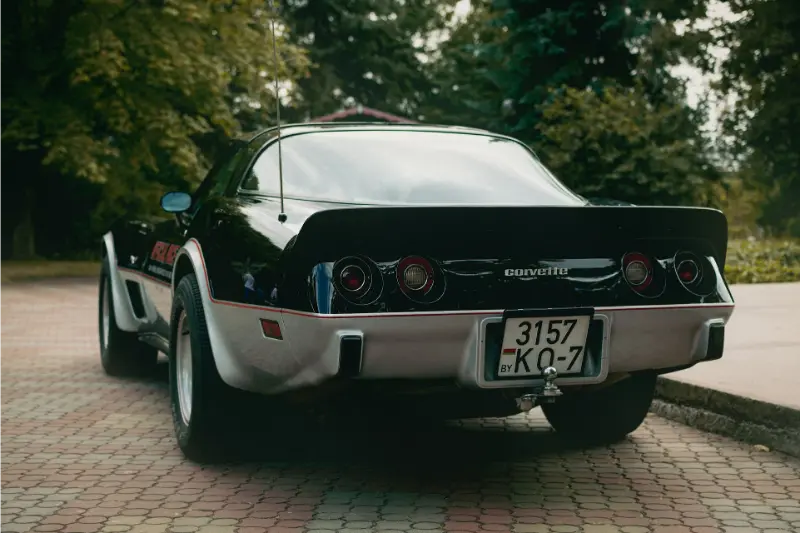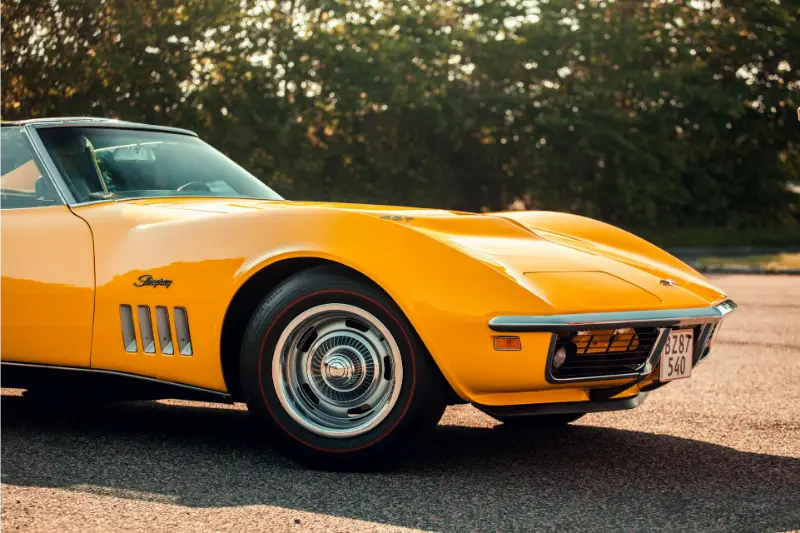
In the thrilling tale of American cars, one vehicle stands out—the 1963 Chevrolet Corvette Sting Ray. This masterpiece didn’t just cruise onto the scene; it roared, becoming a symbol of pure American muscle. Let’s rev up the engine and explore the journey of this iconic car.
Table of Contents
What is the Origin of the Sting Ray?
The Sting Ray’s story begins in the late 1950s when Chevrolet aimed to challenge European sports car dominance. Enter Bill Mitchell, the design genius behind the Sting Ray project. Mitchell and his team set out to redefine American sports cars, leading to the birth of the Sting Ray—a blend of elegance and performance.
Quote from Bill Mitchell: “We wanted an elegant and functional design that would resonate with the spirit of speed.”
How did the Sting Ray change car design?
The Sting Ray was a rebel in the world of muscle cars. Mitchell ditched the boxy look for an aerodynamic, flowing design crafted from lightweight fiberglass. It wasn’t just a car; it was a visual masterpiece, setting new standards for style and efficiency. The mid-engine configuration wasn’t just a shift; it was a game-changer, influencing future generations.
What was the total production volume of the 1963 Chevrolet Corvette Sting Ray?
In 1963, a total of 21,513 Chevrolet Corvette Sting Rays were produced, representing a significant increase of over 50% from the previous year’s production numbers. This growth was fueled by the Corvette Sting Ray’s innovative design, powerful performance, and growing popularity among enthusiasts.
The production breakdown by model variant reveals the Corvette Sting Ray’s versatility and appeal to a wide range of drivers:
Coupé: 10,594 units (49.24% of total production)
Convertible: 10,919 units (50.76% of total production)

The nearly even split between coupé and convertible body styles indicates that both options were equally desired by Corvette enthusiasts.
For those seeking even higher performance, the Z06 package offered enhanced power and handling. The Z06 production breakdown is as follows:
Z06 Coupé: 2,575 units (12.01% of total production)
Z06 Convertible: 1,364 units (6.33% of total production)
The combined production of 3,939 Z06 models highlights the performance-oriented buyers who sought the ultimate driving experience.
What was the price of a 1963 Sting Ray?
The base price of a 1963 Chevrolet Corvette Sting Ray was $4,037. This price varied depending on the chosen options and configuration, but it provides a general starting point for understanding the overall cost of the vehicle.
Here’s a breakdown of the pricing for the different model variants:
Coupe: $4,037
Convertible: $4,237
The Z06 performance package, which offered enhanced power and handling, added an additional $538 to the base price. This resulted in the following pricing for Z06 models:
Z06 Coupe: $4,575
Z06 Convertible: $4,775
What is the Current Price of Sting Ray?
The price of a Sting Ray depends on the year, model, condition, and mileage. Older Sting Rays, like the 1963 model, can be quite expensive, with an average price of $70,000 to $100,000. Newer Sting Rays, like the 2024 model, are also expensive with a starting price of $69,995.
What makes the Sting Ray powerful and agile?
Beyond its stunning looks, the Sting Ray flexed serious muscle on the road. The standard 327 cubic inch V8 was a capable engine, producing around 300 horsepower, but it was the 427 cubic inch V8 that took things to another level. With its 425 horsepower output, this powerful engine transformed the Corvette Sting Ray into a true performance icon.
The 427 V8, with its raw power, pushed the Sting Ray to incredible speeds—0-60 mph in under five seconds and a top speed exceeding 150 mph. Its balanced handling and achievements in racing solidified its status as a performance icon.
Achievement: Dominance in SCCA Trans-Am and endurance racing events solidified its reputation on the track.
Why is the Sting Ray an icon of American cool?

The Sting Ray wasn’t just a car; it became a cultural symbol of American cool. Its sleek design, powerful performance, and association with freedom turned it into an icon. Hollywood embraced it, featuring the Sting Ray in films like “The Sting” and “Bullitt,” captivating audiences with its on-screen charisma. The Corvette’s theme song, “Sting Ray,” further elevated its status in the hearts of the youth, linking it with rebellion and adventure. Beyond entertainment, the Sting Ray influenced fashion, design, and lifestyle, embodying the spirit of the ’60s.
Why do people consider the Sting Ray a timeless collector’s gem?
The Sting Ray’s allure hasn’t faded; it’s a collector’s dream. Its timeless design and cultural significance have kept its value soaring over the decades. Enthusiasts worldwide seek this automotive gem, making it a sought-after collectible vehicle.
On top of that, the 1963 Corvette coupe is special because it has some unique features that make it a prized collector’s item. It comes with things like air conditioning, a big 36-gallon fuel tank, and fancy leather seats. If a Corvette has these cool extras, it can be way more expensive than the regular ones. People are willing to pay a lot more, sometimes tens of thousands of dollars extra, for these special options. These rare features show just how much people love and value the 1963 Corvette coupe, making it a super popular choice for collectors and fans.
How did the Sting Ray influence future car technology?
The Sting Ray’s impact on automotive technology reverberates through the years. Its mid-engine layout, lightweight construction, and focus on aerodynamics became guiding principles for high-performance sports cars. Aspects of StingRay’s design philosophy found a renaissance in the 2020 C8 Corvette, showcasing a legacy that evolves with time.
What awards did the Sting Ray win for its excellence?
The Sting Ray’s excellence received formal acknowledgment through prestigious awards. Its groundbreaking design and exceptional performance earned accolades, solidifying its position among the elite in the automotive world.
Noteworthy Achievement: Winner of the Car Life Magazine’s “Engineering Excellence Award” in 1963.
A Legacy of Innovation and Excellence
The 1963 Chevrolet Corvette Sting Ray isn’t just a car; it’s a legend. Its impact on American muscle cars is profound. The Sting Ray pushed boundaries, inspiring innovation not only in muscle cars but across the entire automotive industry. Its mid-engine layout, lightweight construction, and aerodynamic emphasis became benchmarks for high-performance sports cars.

The Sting Ray’s legacy as an American automotive icon is unshakable. It embodies the essence of American performance, style, and innovation. Its design remains a timeless muse for designers and engineers, securing its place among the most iconic vehicles ever created.
In the symphony of American cars, the Sting Ray played a solo that continues to resonate—a melody of innovation, power, and coolness. Drive on, Sting Ray, for your legacy echoes in the heartbeats of every American muscle car that follows.








